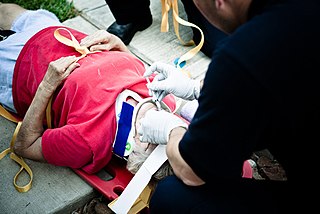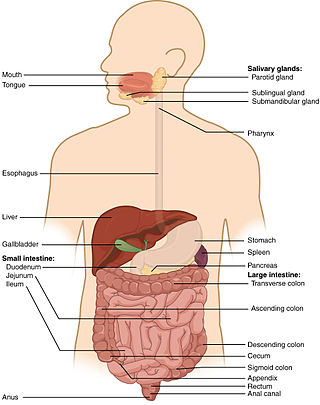Related Research Articles

Alcoholism is the continued drinking of alcohol despite negative results. Problematic use of alcohol has been mentioned in the earliest historical records, the World Health Organization (WHO) estimated there were 283 million people with alcohol use disorders worldwide as of 2016. The term alcoholism was first coined in 1852, but alcoholism and alcoholic are stigmatizing and discourage seeking treatment, so clinical diagnostic terms such as alcohol use disorder or alcohol dependence are used instead.

Alcohol intoxication, also known in overdose as alcohol poisoning, commonly described as drunkenness or inebriation, is the behavior and physical effects caused by a recent consumption of alcohol. In addition to the toxicity of ethanol, the main psychoactive component of alcoholic beverages, other physiological symptoms may arise from the activity of acetaldehyde, a metabolite of alcohol. These effects may not arise until hours after ingestion and may contribute to the condition colloquially known as a hangover.
Drunk driving is the act of operating a motor vehicle with the operator's ability to do so impaired as a result of alcohol consumption, or with a blood alcohol level in excess of the legal limit. For drivers 21 years or older, driving with a blood alcohol concentration (BAC) of 0.08% or higher is illegal. For drivers under 21 years old, the legal limit is lower, with state limits ranging from 0.00 to 0.02. Lower BAC limits apply when operating boats, airplanes, or commercial vehicles. Among other names, the criminal offense of drunk driving may be called driving under the influence (DUI), driving while intoxicated or impaired (DWI), operating [a] vehicle under the influence of alcohol (OVI), or operating while impaired (OWI).

An emergency department (ED), also known as an accident and emergency department (A&E), emergency room (ER), emergency ward (EW) or casualty department, is a medical treatment facility specializing in emergency medicine, the acute care of patients who present without prior appointment; either by their own means or by that of an ambulance. The emergency department is usually found in a hospital or other primary care center.

Driving under the influence (DUI) is the offense of driving, operating, or being in control of a vehicle while impaired by alcohol or drugs, to a level that renders the driver incapable of operating a motor vehicle safely. Multiple other terms are used for the offense in various jurisdictions.
A dram shop is a bar, tavern or similar commercial establishment where alcoholic beverages are sold. Traditionally, it is a shop where spirits were sold by the dram, a small unit of liquid.

Major trauma is any injury that has the potential to cause prolonged disability or death. There are many causes of major trauma, blunt and penetrating, including falls, motor vehicle collisions, stabbing wounds, and gunshot wounds. Depending on the severity of injury, quickness of management, and transportation to an appropriate medical facility may be necessary to prevent loss of life or limb. The initial assessment is critical, and involves a physical evaluation and also may include the use of imaging tools to determine the types of injuries accurately and to formulate a course of treatment.

A breathalyzer or breathalyser is a device for measuring breath alcohol content (BrAC). The name is a genericized trademark of the Breathalyzer brand name of instruments developed by inventor Robert Frank Borkenstein in the 1950s.
Emergency psychiatry is the clinical application of psychiatry in emergency settings. Conditions requiring psychiatric interventions may include attempted suicide, substance abuse, depression, psychosis, violence or other rapid changes in behavior.

Blunt trauma, also known as blunt force trauma or non-penetrating trauma, describes a physical trauma due to a forceful impact without penetration of the body's surface. Blunt trauma stands in contrast with penetrating trauma, which occurs when an object pierces the skin, enters body tissue, and creates an open wound. Blunt trauma occurs due to direct physical trauma or impactful force to a body part. Such incidents often occur with road traffic collisions, assaults, sports-related injuries, and are notably common among the elderly who experience falls.

A drug-related crime is a crime to possess, manufacture, or distribute drugs classified as having a potential for abuse. Drugs are also related to crime as drug trafficking and drug production are often controlled by drug cartels, organised crime and gangs. Some drug-related crime involves crime against the person such as robbery or sexual assaults.

Lincoln Hospital is a full service medical center and teaching hospital affiliated with Weill Cornell Medical College, in the Mott Haven neighborhood of the Bronx, New York City, New York. The medical center is municipally owned by NYC Health + Hospitals.

The Affordable Care Act (ACA), formally known as the Patient Protection and Affordable Care Act (PPACA) and colloquially known as Obamacare, is a landmark U.S. federal statute enacted by the 111th United States Congress and signed into law by President Barack Obama on March 23, 2010. Together with the Health Care and Education Reconciliation Act of 2010 amendment, it represents the U.S. healthcare system's most significant regulatory overhaul and expansion of coverage since the enactment of Medicare and Medicaid in 1965.

Trauma in children, also known as pediatric trauma, refers to a traumatic injury that happens to an infant, child or adolescent. Because of anatomical and physiological differences between children and adults the care and management of this population differs.

Geriatric trauma refers to a traumatic injury that occurs to an elderly person. People around the world are living longer than ever. In developed and underdeveloped countries, the pace of population aging is increasing. By 2050, the world's population aged 60 years and older is expected to total 2 billion, up from 900 million in 2015. While this trend presents opportunities for productivity and additional experiences, it also comes with its own set of challenges for health systems. More so than ever, elderly populations are presenting to the Emergency Department following traumatic injury. In addition, given advances in the management of chronic illnesses, more elderly adults are living active lifestyles and are at risk of traumatic injury. In the United States, this population accounts for 14% of all traumatic injuries, of which a majority are just mainly from falls.

Drunk driving is the act of driving under the influence of alcohol. A small increase in the blood alcohol content increases the relative risk of a motor vehicle crash.
Drunk walking describes people intoxicated by alcohol walking in public spaces. While there are long-standing social stigmas and laws against drunk driving, only more recently have the personal and social dangers of drunk walking become apparent. One study on pedestrians struck by vehicles found that alcohol users were twice as likely to cross against the signal or outside of a crosswalk than sober pedestrians. Alcohol use was also associated with more severe injuries and longer hospital stays.

Auto-brewery syndrome(ABS) (also known as gut fermentation syndrome, endogenous ethanol fermentation or drunkenness disease) is a condition characterized by the fermentation of ingested carbohydrates in the gastrointestinal tract of the body caused by bacteria or fungi. ABS is a rare medical condition in which intoxicating quantities of ethanol are produced through endogenous fermentation within the digestive system. The organisms responsible for ABS include various yeasts and bacteria, including Saccharomyces cerevisiae, S. boulardii, Candida albicans, C. tropicalis, C. krusei, C. glabrata, C. kefyr, C. parapsilosis, Klebsiella pneumoniae, and Enterococcus faecium. These organisms use lactic acid fermentation or mixed acid fermentation pathways to produce an ethanol end product. The ethanol generated from these pathways is absorbed in the small intestine, causing an increase in blood alcohol concentrations that produce the effects of intoxication without the consumption of alcohol.
A sobering center is a facility or setting providing short-term recovery and recuperation from the effects of acute alcohol or drug intoxication. Sobering centers are fully staffed facilities providing oversight and ongoing monitoring throughout the sobering process. Sobering centers may be alternatives to jail and emergency departments, as well as drop-in centers. There is a small number of sobering centers around the world. There are over 40 established sobering centers in the United States.
Screening, Brief Intervention and Referral to Treatment (SBIRT) is a model that encourages mental health and substance use screenings as a routine preventive service in healthcare.
References
- ↑ "Fact Sheet". Ensuring Solutions to Alcohol Problems. George Washington University Medical Center. Archived from the original on August 15, 2005.
{{cite web}}: CS1 maint: unfit URL (link) - ↑ "Questions & Answers About Alcohol Exclusions". Ensuring Solutions to Alcohol Problems. George Washington University Medical Center. Archived from the original on July 26, 2011.
{{cite web}}: CS1 maint: unfit URL (link) - ↑ Rivara FP, Tollefson S, Tesh E, Gentilello LM (January 2000). "Screening trauma patients for alcohol problems: are insurance companies barriers?". The Journal of Trauma. 48 (1): 115–8. doi:10.1097/00005373-200001000-00019. PMID 10647575.
- ↑ "Repeal of the Uniform Accident and Sickness Policy Provision Law (UPPL)". American Society of Addiction Medicine. July 2005.
- ↑ Cimons M (2004). Challenging a Hidden Obstacle to Alcohol Treatment. Washington, DC: Ensuring Solutions to Alcohol Problems.
- ↑ Gentilello LM, Rivara FP, Donovan DM, Jurkovich GJ, Daranciang E, Dunn CW, et al. (October 1999). "Alcohol interventions in a trauma center as a means of reducing the risk of injury recurrence". Annals of Surgery. 230 (4): 473–80, discussion 480–3. doi:10.1097/00000658-199910000-00003. PMC 1420896 . PMID 10522717.